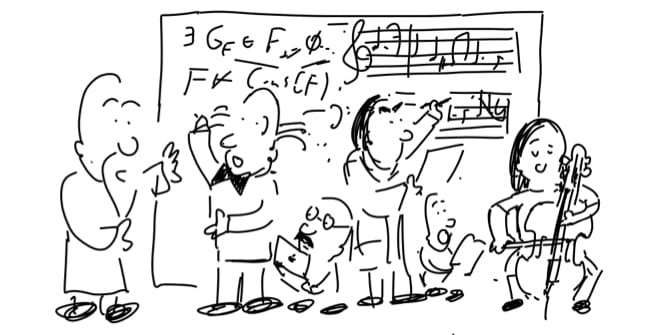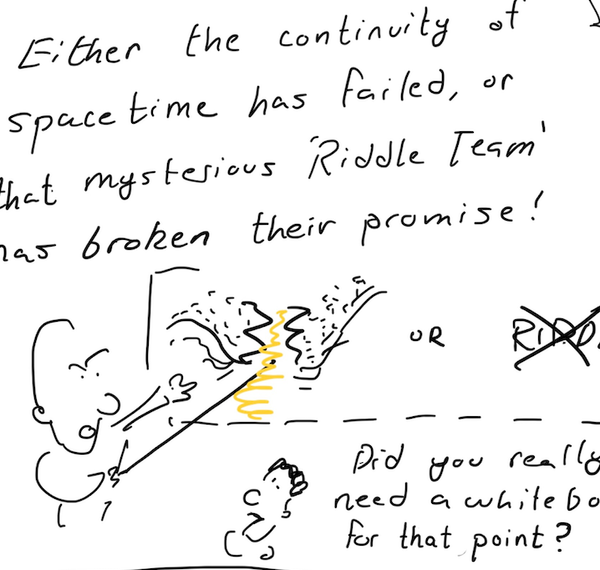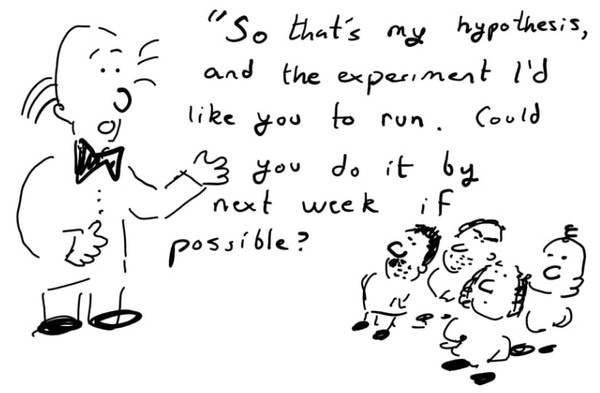Riddle Fortnightly No. 10

Of 25 August, 2024
Dear Readers,
Welcome to this summer’s third installment of the Riddle Fortnightly. As you break out the tea and biscuits, and settle down with this edition, I wanted to offer a chant-worthy motto for the week ahead. That, and a mind-twister of a quote that will have you questioning your sanity.
And thus also must that picture be taken of a Dolphin clasping an Anchor: that is, not really, as is by most conceived out of affection unto man, conveighing the Anchor unto the ground: but emblematically, according as Pierius hath expressed it, The swiftest animal conjoyned with that heavy body, implying that common moral, Festina lentè: and that celerity should always be contempered with cunctation. (Sir Thomas Browne, 1605–1682, “Of the Picture of Dolphins”)
In this age where skimming readers prompt writers to produce increasingly skimmable content, there’s something deeply satisfying about a chunk of prose so dense that one has to ponder over it to make sense of it. And what a wondrous sense emerges! The writer David Bentley Hart chose this as one of his two favorite passages of English prose. It has philosophy, it has rhythm, it even has new vocabulary – a gift to the aspiring erudite!
But whether or not you choose to remind your friends and nemeses to “contemper their celerity with cunctation,” I hope the phrase Festina lentè! (Make haste, slowly) rings through your week.
In this edition of the Fortnightly we have
- An Obsidian and Readwise workflow for auto-generating flashcards from study material, including syncing them to Anki.
- A miniature book review of David Brooks’ “Bobos in Paradise”.
- A new riddle, and solutions to the last two riddles, due to an omission on our part.
Hopefully we’ve added enough cunctation.
Kincaid

Thinking Tools: Automatic Reading Flashcards with Readwise and Obsidian
Apps, tools, and workflows for thinking better with technology.
A few years ago, pre-ChatGPT, a collective called Psionica sought to spark an upgrade in human learning with something called ‘Autocard’. The premise was simple. We read things every day; we remember vanishingly little. Flashcards, and particularly spaced repetition, are an unreasonably effective means of committing things to long term memory, requiring only a handful of minutes per card, spread out over years. But taking the time to write cards is a huge bottleneck. Autocard, the dream was, would create Anki-ready flashcards for you, providing at least a first draft to be refined.
Being pre-ChatGPT, Autocard never worked very well, and psionica eventually dissolved. (I believe it used a GPT-2 era BERT model.) But the idea remained, and has been implemented in a few places, like RemNote, and various semi-defunct Obsidian plugins like “Auto Anki”.
I recently tried to recreate this myself, using the existing AI features of two ubiquitous tools for thought: Readwise Reader and Obsidian. Readwise, a read-it-later tool, has an OpenAI-powered “Ghostreader” that can be prompted with context from your reading material and highlights. And Obsidian has a number of plugins for extracting and syncing flashcards between markdown and Anki. Hence the very simple idea behind this automation: ask the Ghostreader to write flashcards in a markdown format usable by Obsidian’s plugins, where they can be synced to Anki. Voila!
Were it that easy, it would hardly merit description, except to exude at how easy formerly magical technological acts have become. As it turns out, there were a few subtleties worth documenting.
First, I used the plugin Obsidian_to_Anki with the Q: and A: format to extract flashcards from my Obsidian notes. Markdown flashcards look like this:
Q: How long do Riddlers live? #flashcard
A: They are immortal.
After a bit of configuration described in their docs, you can sync these cards to Anki by running a command in Obsidian.
I then configured Readwise’s Ghostreader to create highlights in that format, by creating a custom prompt in Reader’s settings, using the Jinja2 templating language supported by Readwise to supply the document content, my highlights from it, and details like the document title and author name. While testing this, I made a few refinements to discourage vague questions and nebulous references to ‘the document’ – but you can refine this to your needs.
As a teacher and mentor, you are preparing a set of flashcards for a student based off of the following text, {{ document.title }}. To most effectively engage the student, you are also reviewing his highlights in the document. You will then prepare a set of flashcards to help him remember the key ideas from his highlights.
Below is the full document text:
"""
{% if (document.content | num_tokens) > 25000 %}
{{ document.html | central_paragraphs | join('\n\n') }}
{% elif (document.content | num_tokens) > 2500 %}
{{ document.content | central_sentences | join('\n\n') }}
{% else %}
{{ document.content }}
{% endif %}
"""
And here are the student’s highlights from this document.
"""
{% for highlight in highlights %} {{ highlight.content }} {{ "\n\n" }} {% endfor %}
"""
Please write at least four but up to forty sets of questions and answers that extract the key ideas and most relevant details from the document, paying special attention to the student’s highlights. Try to create roughly one question per highlight. For example, if one of the student’s highlights is a factual statement, one question-answer pair should rephrase the fact into a question and provide the answer. You may also use the context surrounding each highlight to provide the best questions possible.
Your questions should elucidate the most unexpected and useful information from the document. There should only be one idea per question, following Andy Matushak’s advice on creating flashcards. Avoid vague questions like "what did X say about Y" -- instead, give some detail and ask for more, or for the reasoning behind it. Avoid references to 'the document', or asking about the context of something with respect to the document, as the student will use these flashcards separately from the original source. If you want to refer to the document in the question or answer, use its title, "{{ document.title }}". Similarly, always refer to the author as {{ document.author }}. Above all, make the questions and answers beautiful.
Your questions and answers should be provided in the below format, with three blank lines between question sets.
Q: Question Here #flashcard
A: Short answer here.
{% if document.note %}
Do not repeat information or questions in the student's own notes, which are below:
"""{{ document.note }}"""
{% endif %}
Again, please provide roughly one question-answer pair per highlight.
This works beautifully with GPT 4o, and inserts flashcard-formatted chunks of markdown in Readwise’s document note.
However, the Readwise Obsidian plugin, which syncs that note into your Obsidian notes, somehow mangles the formatting , removing newlines. Without them, Obsidian_to_anki doesn’t properly detect the flashcards.
To fix this, visit the plugin’s formatting settings (with the Obsidian command “Readwise Official: Customize formatting”), and replace {{document_note}} with the following script, which will scan for lines beginning in A: and add a newline to the end.
{% set notes = document_note or '' %}{% for line in notes.split('\n') %}{{ line }}
{% if 'A:' in line %}{{ '\n' }}{% endif %}{% endfor %}
To generate these flashcards in Readwise Reader, activate Ghostreader, click on your custom prompt – and, after a few seconds of animated ghost bobbing up and down, something like the following will be appended to your document note.
Q: What is the significance of the phrase "palace of crystal" in Dostoyevsky's philosophy? #flashcard
A: The "palace of crystal" represents the counterfeit offerings of the world that sedate us and strip us of our humanity, contrasting the value of facing life's real struggles.
From there, it will migrate to the corresponding literature note in Obsidian. There, you can spiff up the flashcard – sharpening the question and refining the answer as appropriate – or, if it doesn’t seem worth remembering, you can just delete it.
But if it does, now you have it on an express route to your long-term memory.
Riddle Book Club’s Mini Book Review
Readings from ’round the web, collected by our resident spyder: the Riddler, whose grumbled commentary you’ll hear below.
- David Brooks - “Bobos in Paradise: the new upper class and how they got there”, short book, pub. 2000. Bookshop.org Link A (sometimes bitingly) humorous examination of the cultural changes brought on by the Information Age, and the contradictions therein.
The Riddler has a question for the youngen’ out there. Does anybody print things these days? If not, he has a contention: you’re missing out.
You see, printing things is one of the Riddler’s favorite activities. Blogs, essays, comic strips, ebooks, paintings from the Google Art project, and – when he’s feeling frisky – infinite-scroll webpages. All have passed through the Riddler’s Mammoth printer with an air of conquest and that pleasing cha-cha-cha-cha sound the Riddler takes as the sonic representation of information being made physical.
(Incidentally, the Riddler also has a 3D printer, but uses it far less. One can only have so many figurines of Ned Ludd.)
Printing is also the best metaphor the Riddler could come up with for the central theme in David Brooks quarter-century-old bit of social commentary, Bobos in Paradise. ‘Bobos’ stands for “bourgeois bohemians” – it was a cute acronym Brooks’ reviewers optimistically forecast would join the American lexicon alongside terms like “hippie.” As best the Riddler can tell, that hasn’t happened. Perhaps because many Americans aren’t clear what exactly ‘bourgeois’ or ‘bohemian’ really mean.
‘Bourgeois,’ as Brooks (and Marx) use it, refers to that tier of the upper class just below the aristocracy. In Marx’s day, the bourgeois were shopkeepers, accountants, big-company managers; they went to Harvard and Yale (because their fathers had), and though they were competent managerial professionals, they abhorred ‘eggheads’ and didn’t try to seem intellectual. Instead, they advertised their hereditary significance with conspicuous consumption: giant houses with parlors, gaudy, expensive furniture, jacuzzis and yachts. You see them in The Great Gatsby, or in the character Homais in Flaubert’s Madame Bovary.
‘Bohemians,’ as Brooks points out, have typically represented the antithesis of the bourgeois. They are the Romantics; they glorify artists living in poverty, following their passions, experiencing fully the joys of the ‘simple life’. They are also the hippies, the disruptive anti-institutionalists who shake their fists at ‘the Machine’ or ‘the System’ – systems run by the bourgeois. Throughout the ‘60s and ‘70s, the two camps seemed on the verge of a class war.
Then, mysteriously, the war ended - with no clear victor. Instead, the bourgeois and the bohemians merged – into the “Bobos”, our current upper class. Conspicuous consumption is now out, environmentally-responsible minimalism is in. Wearing tuxedos and going to the opera is out; the new upper class wears beaten-up jeans and listens to country music. Also out: being a loyal member of the ‘system’. Today’s CEOs act like bohemian visionaries and talk about ‘disruption’. Today’s Bobo employees view their work as an intensely personal endeavor – a source of meaning and personal fulfillment. If they don’t get it, they’ll leave. Bobos don’t like to think of themselves as an upper class, but they dominate our institutions (like The New York Times, Harvard, Yale, etc) and their values dominate our media.
This is a problem because, as Brooks contests, the Bobo values involve a paradoxical reconciliation of two opposing philosophies. And the source of that paradox may well be – cha-cha-cha-cha-cha-cha – the Information Age.
Writes Brooks,
The central feature of the information age is that it reconciles the tangible with the intangible. It has taken products of the mind and turned them into products of the marketplace. [1]
Or, as content ‘creators’ now call it, ‘the marketplace of ideas.’ As a consequence,
Just as the cultural forces of the information age have created businesspeople who identify themselves as semi-artists and semi-intellectuals, so nowadays intellectuals have come to seem more like businesspeople. [1]
In this framing, you can anticipate the self-righteous gong the Riddler probably overused in his last column. “Surely,” he might be about to say, “if intellectuals are turning into businesspeople, that can only portent ruinous cultural decay!” And the Riddler is very tempted to sound this gong, but then scrutinized it over more carefully, and realized that he’s not sure which way to hit it. Investors, CEOs, and the legions of regular businessfolk – they are all becoming more intellectual. Unlike the former bourgeois, with their contempt for Eggheads, they take ideas like environmentalism and social inequalities seriously. But this osmosis cuts both ways: the formerly austere and isolated intellectual class is becoming more commercially oriented.
So, should the Riddler strike his gong or not? On one hand, larger numbers of people taking an interest in the arts and sciences seems pretty good. It means more patronage (money!) for the poor, bohemian artists; more recognition (and money!) for the poor, overworked scientists, previously laboring in obscurity; more public engagement with relevant ideas and (money for!) those who publish them.
On the other, as Brooks suggests, all of this new interest (and especially the money) very easily corrupts the artists, scientists, and authors. It’s like a Columbian exchange. The much more numerous businessfolk (the bourgeoisie), trading with the fabled Island of Intellect. The businessfolk get lots of nice ideas, Malcolm Gladwell-style books like Outliers and The Tipping Point, packaged for commercial success – but the intellectual islanders are pulled into a capitalist maelstrom.
To illustrate this, Brooks gives a depiction of the pre-Bobo, pre-information age intellectual class. They were a snobbish bunch, aloof, contentious, and self-important:
Their memoirs are filled with intellectual melodrama: When Edmund Wilson published his review of so-and-so, they recount, we knew life would never be the same again — as if a book review could alter reality, as maybe in those days it could…
They considered themselves, and perhaps were, shapers of history. “A single stroke of paint, backed by work and a mind that understood its potency and implications, could restore to man the freedom lost in twenty centuries of apology and devices for subjugation,” wrote the painter Clyfford Still, apparently without being ridiculed. They went in big for capital letters. “These three great forces of mind and will—Art, Science and Philanthropy—have, it is clear, become enemies of Intellect,” Jacques Barzun declared in 1959, launching off into characteristically grand territory. And they issued the sort of grand and often vaporous judgments that today strike us as ridiculous. [1]
But these same traits that made them commercially unpalatable and generally unlikeable (even to each other) gave them the freedom to wax philosophic on a grand scale. They played with big ideas and offered grand theories, unhindered by the self-consciousness that, for today’s writers and thinkers, is perched censoriously on their shoulder. This had its advantages:
At the heart of this style was an exalted view of the social role of the intellectual. In this view the intellectual is a person who stands apart from society, renouncing certain material advantages and instead serving as conscience for the nation. Intellectuals are descendants of Socrates, who was murdered by the polis because of his relentless search for truth… They are influenced by the Russian notion of the intelligentsia, a secular priesthood of writers and thinkers who participated in national life by living above it in a kind of universal space of truth and disinterestedness, rendering moral judgments on the activities below. [1]
The Riddler will add that, though Brooks is concerned with the political contributions of these intellectuals, this same ‘universal space of truth and disinterestedness’ arguably applies even more strongly in the natural sciences. In mathematics, physics, or biology, many breakthroughs have come from Darwin, Poincaré, or Einstein-type figures chasing their own whims in isolation, without any commercial or reputational pressures.
Then came the Information Age. The internet and its kin kicked off that Columbian exchange with the Intellectual Island, and transformed the exchange of ideas from a secluded conversation among an aloof few into a bustling commerce. “A central feature of the information age,” Brooks writes “is that it reconciles the tangible with the intangible.” We all trade in information now. In so doing, we have “taken products of the mind and turned them into products of the marketplace.”
Cha-cha-cha-cha, goes the Riddler’s printer, still printing that infinite-scroll webpage. All those intangible, ethereal ideas from the intellectual priesthood, are being printed into something like dollar bills. What does the Riddler know? The Mind, entering the Marketplace! Isn’t that some contradiction? At the very least, as Brooks points out, it’s a radical departure. In the pre-Bobo days (e.g. the 1950s),
Commerce was the enemy of art. Norman Mailer got into a lot of trouble with his intellectual friends when his novel The Naked and the Dead became a bestseller. Its commercial success was taken as prima facie evidence that there was something wrong with it. [1]
But nowadays,
Intellectuals have come to see their careers in capitalist terms. They seek out market niches. They compete for attention. They used to regard ideas as weapons but are now more inclined to regard their ideas as property. They strategize about marketing, about increasing book sales. Norman Podhoretz was practically burned alive for admitting in his 1967 memoir, Making It, that he, like other writers, was driven by ambition. That book caused outrage in literary circles and embarrassment among Podhoretz’s friends. Now ambition is no more remarkable in the idea business than it is in any other. [1]
But while the Riddler is still hovering over his self-righteous gong, he pauses to reflect how many good things have come from this ambition to be popular instead of aloofly inscrutable like Kant. We have fewer Jacques Barzun-type sentences (“These three great forces of mind and will—Art, Science and Philanthropy—have, it is clear, become enemies of Intellect” – what does that even mean?) We have more Richard Feynman-like characters who, like Michio Kaku or Stephen Hawking, take care to make their ideas comprehensible to everyone. As a result, higher education is much more accessible; barriers to entry in fields like sociology or economics are lower. If the result is that some intellectuals develop a weakness for caviar and four-star hotels and spend more time trying to write best-sellers and appear on cable news shows and less time following their whims into unpalatable areas – is that really so bad?
Ultimately, Brooks comes out in favor of the new system. Some of the radical energy of earlier intellectuals has probably been lost. We’re a more conformist lot, more mindful of sales figures and resumes. But,
Today’s careerist intellectuals have a foot in the world of 401 (k) plans and social mobility and so have more immediate experience with life as it is lived by most of their countrymen. This grounding means that intellectuals have fewer loony ideas than did intellectuals in the past. Few of them fall for visions of, say, Marxist Utopias. Fewer idolize Che Guevara—style revolutionaries. On balance, it’s better to have a reasonable and worldly intellectual class than an intense but destructive one. [1]
This leads to Brooks’ unexpected (but convincing) argument that the Bobos, who are by-and-large culturally liberal, card-carrying Democrats, are actually conservatives in the mold of Edmund Burke. They value conservation – not only of land, but of their neighborhoods, and of the institutions they now run. And though they are the most educated upper class America has had,
they are not overwhelmingly impressed by the power of expertise. Instead, they seem acutely aware of how little even the best minds know about the world and how complicated reality is compared to our understanding. They know, thanks to events like the war in Vietnam, that technocratic decision making can produce horrible results when it doesn’t take into account the variability of local contexts. They are aware, thanks to the failure of the planned economies of eastern Europe, that complex systems cannot be run from the center. In other words, they are epistemologically modest, the way such conservatives as Burke… would have wanted them to be.^[Though the Riddler feels compelled to note that - in his day - Burke was considered something of a liberal. He supported American independence and their democracy project because, to him, it seemed well thought-out. He raged against French independence and in favor of the monarchy because he didn’t think it well thought-out.]
In other words, that fusion of the information age – that convergence of products of the mind and the marketplace – has tempered both. Gone are the intellectual radicals like Marx, who, after spending years locked in the basement of the British Library, emerge with new intellectual frameworks that spark decades of conflict. Gone also are the spurts of raw physical greed that arguably compelled colonialism and perpetuated slavery. The Bobos have achieved a great balancing act.
And this all sounds fairly reasonable until Brooks writes,
For the first time since the 1950s, it is possible to say that there aren’t huge ideological differences between the parties. One begins to see the old 1950s joke resurface, that presidential contests have once again become races between Tweedledum and Tweedledumber. Meanwhile, the college campuses are not aflame with angry protests. Intellectual life is diverse, but you wouldn’t say that radicalism of the left or right is exactly on the march.
“Why,” one might ask the Riddler, “are you thinking about a book published a full quarter century ago? Times have changed, man.”
To which the Riddler can only respond: have they?
One thing is for sure. Printing is a vanishing art. The Riddler will shed tears over this. If, at the turn of the century, the information age was realized through Epson laser printers, this last remaining bridge between the physical and digital has now fallen. The information age is now realized through tweets and tiktoks flying between iPhones. Brooks wrote of the reconciliation of “the tangible with the intangible”. Now, the intangible has, again, become mostly intangible - only glimpsed, briefly, poked at through a little touch screen, before disappearing amongst the flood of novelty that occupies our days.
The Riddler suspects this has something to do with how radically we’ve diverged from Brooks’ predicted future; how so many of the Bobos who tried so hard to be unpretentious were still swept up by ideological fervor, and how – despite communication being physically easier than it has ever been – the citizens of the U.S. have never had more trouble communicating with each other.
But one also notices, reading Brooks’ critique of the 1990s, how little our currents of thought have changed. The ideas that spewed from the Riddler’s printer back then are still spewing, just in 180-character sentence fragments and two-hour YouTube rants. It’s all there: the disillusionment with meritocracy, the tension between capitalist expansion and environmental conservation, the distrust of institutions, bureaucrats, and the “system”, even by those looking to run it. Our much more numerous and publicity-hungry public intellectuals have been passing around recycled fragments from earlier eras – except they, and their readers, are no longer so epistemically modest.
Nietzsche wrote that the cleverest writers “leave it to one’s reader alone to pronounce the ultimate quintessence of our wisdom.” Perhaps the quintessence of Bobos in Paradise, viewed in light of the past decade, is that the Bobos’ marriage of bourgeois and bohemian values never resolved its underlying contradictions. Those have been there all along, ignored but festering, and were all but fated to eventually cause that most hated sound of the Riddler’s printer –
A paper jam.
Fortnightly Riddles
Recall that last week, Johnnie’s gym teacher had figured out a way to measure any integer weight between 1 and 40 with only four weights.
Kudos to friend-of-the-press Caerful Typist for being first to tell us what those weights are: 1, 3, 9, and 27. Powers of 3. Hmm.
This spawns this fortnight’s riddle: for what related question is the answer powers of four?
Solve it? Post your answer as a comment to this newsletter to claim credit : )
Solutions to previous riddles:
Caerful Typist also reminded us that we never posted a solution to last month’s riddle. To recall:
One day, Dyson was hanging out with some other top scientists, when one posed a question to the group: did there exist an integer that could could exactly double by moving its last digit in front? For example, we might start with 367. Moving the digits, it becomes 736 – but this isn’t equal to 2 x 367, so it doesn’t work. Is there any number that does?
Legend has it that Dyson, after a mere five seconds, said “Of course there is, but the smallest such number has 18 digits”. This astounded the room.
What is this number? And how on earth did Dyson find it so quickly?
Finding the number isn’t too hard, though it took this individual much longer than five seconds. The trick is that, given one digit, the one left of it is completely determined, which, in turn, determines the one to the left of that – and so on. If you start with ‘1’ in the ones place, then steal that ‘1’ and move it in front of the number, what now occupies the ones place must be ‘2’. So we have the tens place. The hundreds place must then be ‘4’.
When you have a number \(x\) which, doubled, is greater than 10, you take two steps. The very next number is \(2x\) modulo 10 (the ones place of \(2x\)), with a one ‘carried’, so that the subsequent number is one more than otherwise.
We can represent this graphically. Here, the integers with lines above them represent numbers with a 1 carried. And by applying the operation repeatedly, we discover something unexpected: almost everything connects.

The exceptions are 0 and \(\dot{9}\), which, multiplied by two, just produce themselves. Indeed, \(\dot{9}\) can obviously never be produced by any number except itself, so we can safely ignore it.
The other 18 numbers, however, form one giant loop. You can pick any starting point, and ride the loop until you get back where you started. Then you have yourself a Dyson number.

(Unless the penultimate digit is 0. That doesn’t really work.)
Now, this is a bit of a convoluted set-up. Can we represent those weird dot numbers in regular mathematics? Can we encapsulate the property that, when multiplied by 2, they add one to the result?
Indeed, we can. We can represent them as ‘teenagers’ with multiplication performed modulo 19, e.g. \(\dot{1}\) becomes 11; and 11 x 2 is 22 mod 19, which is 3. Modulo 19, any number greater than or equal to 10 exceeds 19 when multiplied by 2. The modulus then subtracts 19, taking the ones digit plus 1, as desired. Conveniently, numbers less than 10 are unaffected by the modulus.
(We might also derive this trick by noting that \(\dot{9}\) can never be produced except by itself, so, being the largest member of our set of 20, can be chopped off.)
And – 19 is prime. Those who (as Dyson surely did) have played around with modular arithmetic or group theory would likely know that a prime modulus means that multiplying by any number repeatedly will traverse the entire circuit, minus zero -- e.g. that the order of the group modular group of any prime is one less than the prime.





